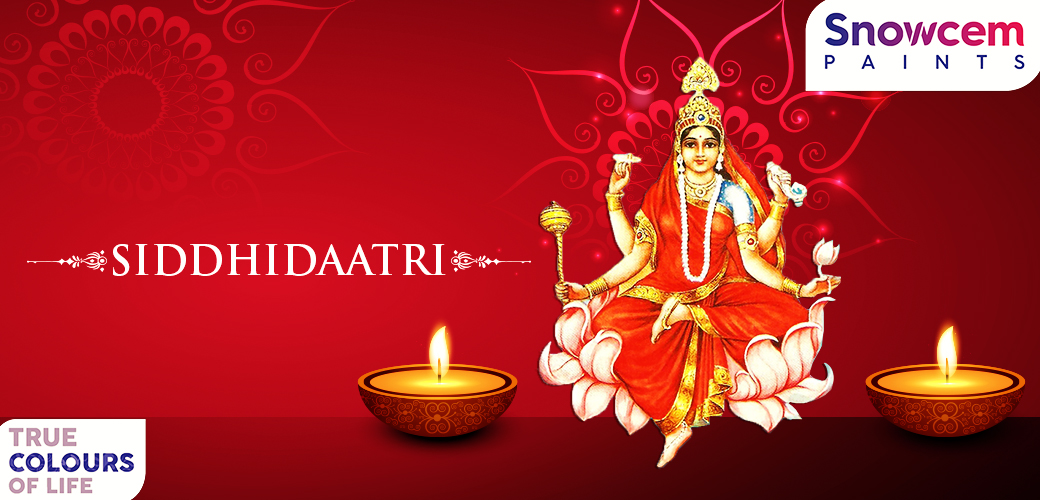
Siddhidatri is the ninth form of Goddess Durga. She is worshipped on the ninth day of Navaratri. Siddhidatri has supernatural healing powers. She has four arms and she is always in a blissful happy enchanting pose. She rides on the lion as her vehicle. She blesses all Gods, saints, yogis, tantrics and all devotees as a manifestation of the Mother Goddess. The color to wear on the seventh day is Purple.
Let the last day of Navratri, i.e. 9th day to play around in listed dress colors be the best as Purple symbolizes luxury and power. This color is associated with royalty too. Purple combines the calm stability of blue and the fierce energy of red. The color purple is often associated with royalty, nobility, luxury, power, and ambition. Purple also represents meanings of wealth, extravagance, creativity, wisdom, dignity, grandeur, devotion, peace, pride, mystery, independence, and magic. The color purple is a rare occurring color in nature and as a result is often seen as having sacred meaning. Lavender, orchid, lilac, and violet flowers are considered delicate and precious. The color purple has a variety of effects on the mind and body, including uplifting spirits, calming the mind and nerves, enhancing the sacred, creating feelings of spirituality, increasing nurturing tendencies and sensitivity, and encouraging imagination and creativity.
The ninth and the last day of Navratri festivities end with the worship of the ninth manifestation of the Goddess Durga, the Goddess Siddhidatri. ‘Siddhi’ means ‘achievements’ or ‘perfection’ and ‘datri’ means ‘the one who gives’. So, when her devotees with full faith revere Maa Siddhidatri, then she blesses them with powers and positive energy.
The ever victorious, Maa Siddhidatri is also known as Goddess Laxmi, hence she is the symbol of wealth, happiness and success.
In her physical appearance, Maa Siddhidatri sits on a lotus flower and rides on a lion. She has four arms. In her right upper hand, she holds chakra and in her right lower hand, a mace (gada). She holds a lotus flower in her left upper hand and a conch shell (shankh) in her left lower hand. Maa Siddhidatri is the symbol of wealth, happiness and success.
Maa Siddhidatri is the symbol of wealth, happiness and success. Siddhidatri is the ultimate form of Shakti or the ‘female goddess’ who is worshiped by all other gods. Mata Siddhidatri has achieved all the 8 siddhis and is thus half the body of Lord Shiva. According to the Markandeya Purana, the eight siddhis are: Anima, Mahima, Garima, Laghima, Prapti, Prakamya, Ishitwa and Vashitwa. Goddess Siddhidatri governs all these siddhis and a person who prays to the Goddess on this day attains all these powers. When we see Lord Shiva in the Ardhnareshwar avatar, Mata Siddhidatri comprises half his body.
How Maa Siddhidatri is worshipped:
As India is a country with diversities, the procedure of worshipping the Goddess Durga is also varied in all parts of our country. In North India, the ninth day of Navratri is the last day of the Ramleela functions, as on this day, Lord Rama is believed to have killed demon Ravana and rescued his wife, the Goddess Sita from his confinement. On “Maha Navami”, little girls up-to 12 years of age visit their neighbor homes to have sacred food (prasad) which consists of puri, chane, halwa, coconut, banana and some money. The devotees of Goddess Durga, who observe fast during Navratri, invite nine girls to their homes to seek blessings of all nine manifestations of the Goddess Durga. Legend it is said that the Lord Shiva worshipped Maa Siddhidatri to attain half form of his body as that of the Goddess Shakti. That’s why, Lord Shiva is also known as “Ardhnareshwar”.
The Maha Mantra that is chanted to seek blessings and attain siddhis from Maa Siddhidatri is:
“Siddh Gandharv Yagyadhair Surair Marairapi, Sevyamana Sada Bhooyaat Siddhida Siddhi Dayanee”

